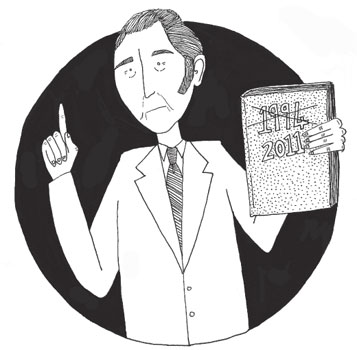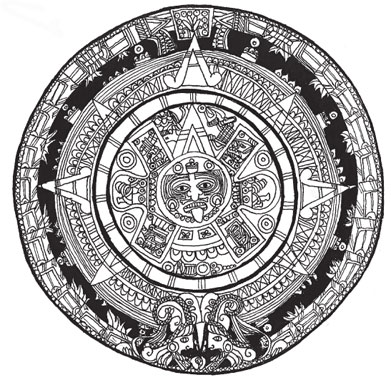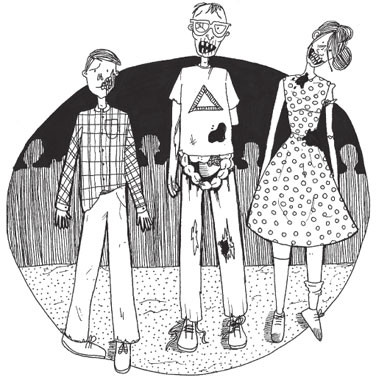The Little Book of the End of the World (22 page)
Read The Little Book of the End of the World Online
Authors: Ken Mooney

Robertson made several predictions of other global events, typically with regards to natural disasters or American elections. In 1976, Robertson predicted that the world would end by 1982 and he supported this prediction on numerous TV broadcasts.
In 1991, he published his own book titled
The New World Order
and discussed the Satan-led global conspiracy to bring about the End of Days. It still hasn’t happened yet.
GOG AND MAGOG AT WORK
The political and economic fallout from 9/11 was not confined to America: the rest of the world felt the repercussions of that day’s events, although where the USA experienced anger, most of the rest of the world was consumed by horror and sympathy.
As American politicians surged towards revenge and retribution, an interesting story came to light when world leaders discussed the events of 9/11 in the context of the End of the World, using language explicitly derived from the Book of Revelations. As this story unfolds, it serves to highlight some of the significant differences between fears and beliefs about the End of the World on both sides of the Atlantic.
George W. Bush, in his effort to gain support for military action in the Middle East, urged European leaders to act since ‘Gog and Magog were at work’ in the area. The phrasing says much about Bush’s fears and the reaction to 9/11 from a certain type of American mentality. However, Bush’s language was somewhat inappropriate for his European equivalents.
In fact, Bush’s biblical reference was so alien to French president Jacques Chirac that Chirac and his aides had to consult with biblical scholars and eschatologists at the University of Lausanne. These scholars provided some contextual explanations for Chirac and his cabinet, raising highly sceptical questions about the usage of such prophecies in the modern world.
Thomas Römer, professor of theology at the University of Lausanne, called any biblical references ‘uncertain and unclear’ and would later retell the story of his involvement in a 2007 edition of the University’s magazine,
Allez savoir!
SEARCHING FOR THE BIG BANG: THE HIGGS-BOSON
In 1964, a group of physicists including Tom Kibble, Gerald Guralnik, C.R. Hagen, Francois Englert, Robert Brout and Peter Higgs formulated a theory for the existence of a new sort of particle. These particles were a necessary part of the standard model of understanding for particle physics but, without proof of their existence, they were just assumed to exist, with the rest of the model taking shape around this question mark.
While the existence of this particle was theorised for thirty years, it only entered public awareness with the publication of
The God Particle
in 1993, published by Leon Lederman and Dick Teresi. As a popular science book,
The God Particle
attempted to explain how or why the existence of this particle would affect the world and help physicists to better understand primal forces. The name of the book was meant as a tongue-in-cheek joke, but nonetheless was adopted by many media outlets as a byword for the particle and the search for it.
This nickname earned these experiments some notoriety over the next two decades, not least due to the construction of the 27km-long Large Hadron Collider (LHC). Not only was this an impressive feat of engineering that involved over 10,000 scientists and engineers, but the size, scope and very nature of the experiments that would take place at the location led some people to believe that the Large Hadron Collider would create an explosion that would lead to some Apocalyptic scenario.
To discover the Higgs-Boson particle, two other particles were accelerated through the LHC and collided, with the resultant impact creating new and diverse particles that had never been observed before. As befitting amateur scientists and media reporting, the words ‘accelerator’ and ‘collision’ led many people to believe that the scientists at CERN (The European Organization for Nuclear Research) were attempting to recreate the Big Bang.
After some initial teething difficulties, the Large Hadron Collider was up and running in 2008. By 4 July 2012, CERN had discovered their first new particle, which was later confirmed to possess the properties expected of the Higgs-Boson. The world didn’t end, but it’s interesting to note that even in the twenty-first century, people can still fear scientific endeavours.
CERN isn’t all about
Top Gear
-style scientific experiments of making particles go really fast and crashing them into each other: we also have it to thank for the existence of the Internet. The first ‘World Wide Web’ was created by Tim Berners-Lee as a program called ENQUIRE, initially used by the several thousand employees of CERN as a means of sharing information between different departments and projects.
HAROLD CAMPING
Pat Robertson is not the only American minister to predict the End of the World through the twentieth and twenty-first centuries: in fact, Harold Camping’s predictions became much better known and reported on – and ridiculed – throughout the world. Part of the widespread knowledge of Camping’s predictions was due to his high-profile radio show, and the large amount of monetary support that he received from followers to help publicise his predictions.
Camping’s initial prediction for the End of the World was 1994, in a book surprisingly called
1994?
Befitting the question mark in the book’s title, Camping also provided 2011 as an alternative date, and when the Apocalypse failed to happen in 1994, this became the accepted date for Camping’s prediction.
Like many other eschatologists, Camping’s predictions were based on close readings of different Bible passages, including application of ‘code’ where the passage in question was not to be taken at face value. Camping gave two specific dates for his Apocalypse: the Rapture would happen on 21 May with massive earthquakes, with the End of the World occurring exactly five months later on 21 October.
Camping was unavailable to the media for comment when the Rapture failed to happen on 21 May 2011, and on 22 May he released a statement outlining his disappointment, including the revision that the Rapture would occur at the same time as the Apocalypse in October.

In June, Camping suffered a stroke, and gradually retired from the public eye in advance of 21 October.
However, when 21 October came and went with no Apocalypse, it appeared that Camping had learned the error of his ways: unlike his predecessors’ habits of consistently revising their predictions, Camping suggested that his attempts to set a date for the Apocalypse were sinful and contravened a specific passage of the Bible, indicating that no man will know the hour of the Endtimes.
Camping returned to closer readings of the Bible, but refused to be drawn on further predictions: instead, he wished to better understand the Bible and its messages and purpose. Camping passed away on 15 December 2013, ultimately never seeing the Rapture that he had expected.
In September 2011, both Camping and Pat Robertson were awarded an Ig Nobel Prize, a parody of the well-known Nobel prizes. They were given the award specifically for their contribution in teaching the rest of the world to be careful when making mathematical assumptions.
A.J. MILLER AND THE DIVINE TRUTH
In the early part of the twenty-first century, Australian A.J. Miller claimed to come to the realisation that he is, in fact, the reincarnated Jesus Christ; adding further weight to his claims, Miller’s partner Mary Suzanne Luck claims to be the reincarnated Mary Magdalene.
Miller has moved on from his old life as an IT specialist and founded a retreat in Queensland where he openly teaches. Miller believes that Jesus’ original teachings have been corrupted since he first taught on Earth, and that he is now teaching and rediscovering the ‘Divine Truth’.
Although Miller has been preaching since 2003, news outlets have only recently begun to pay attention to his teachings. Not all of the coverage has been favourable: some have likened Miller’s behaviour to that of the cult leaders we’ve looked at already. Miller has faced his criticism with good humour, even braving the cynical
This Morning
couch in 2013.
It remains to be seen if Miller’s status will give way to the apocalyptic Second Coming and what role he might play in the pending Enditmes.
2012
While the Mayans get the blame for suggesting that the world would end in 2012, there is little evidence to suggest that they truly believed this: rather, 2012 brought an end to a significantly long cycle, or ‘long count’, of the Mesoamerican calendar.
Some people assumed that this ‘long count’ meant that the Mayans had been divinely inspired, possessing some secret knowledge for the coming Apocalypse, albeit thousands of years in advance of it occurring. In fact, the Mayans did claim that the calendar and their knowledge of it was a gift from the god Itzamna, but they did not claim to know when the world would end.
The Mesoamerican long count calendar measured seasons with a high degree of accuracy unseen in similar cultures of the time: this calendar records dates in a lengthy format, with reference to days, seasons of the sun and moon and also
tun
(360 days),
k’atun
(20
tuns
or 7200 days) and a
b’ak’tun
(20
k’atuns
or 144,000 days.) As the name suggested, the calendar is constructed to be used over a long period: as it works in cycles of 20, the calendar actually resets every couple of thousand years.
The most recent
b’ak’tun
ended on 21 December 2012, resetting the calendar to the same format it had around 5,000 years ago. The Mayans and other Mesoamerican tribes did not attribute any special meaning to this date or any others although, like modern humans, they celebrated the end of every cycle and the start of the next.

Instead, the concept of a 2012 Apocalypse has its origins in the New Age movement of the mid-twentieth century, with many writers discussing the Mesoamerican calendar and other theories without fully understanding them, and seeing connections that may have just been coincidental.
Most of the writers who discussed these Apocalypse theories are well noted for their beliefs in aliens and usage of psychotropic ‘mind-expanding’ drugs; in comparison, most scholars of both Mayan culture and eschatology dismissed the theories of a 2012 Apocalypse as nonsense. But that still did not prevent the date receiving widespread media coverage.
THE ZOMBIE CANNIBAL APOCALYPSE OF 2012
A phrase thrown around in a primarily fictional context, the zombie apocalypse is exactly what it sounds like. Zombies have proven to be a popular enemy in TV, comics and movies through the end of the twentieth century. We’ve already seen how the resurrection of the dead is an important part of the End of the World for many religions; the concept of a zombie apocalypse suggests that these revenants might be more interested in eating our brains and guts than living with us in peace.
The
zombi
is referenced as part of West African voodoo (or
vodou
) and other places where it is practised, including Haiti. The
zombi
in this case is a corpse that has been brought back to life by a
bokor
– or priest/sorcerer – to serve as a slave. There are several records of these
zombis
, by both native writers and visitors: the former highlight the mystical nature of the
zombi,
stressing the power and fear of the
bokor
, while visitors suggested that these
zombis
were actually patients who had been treated with psychotropic drugs and were left susceptible to suggestion and manipulation.

